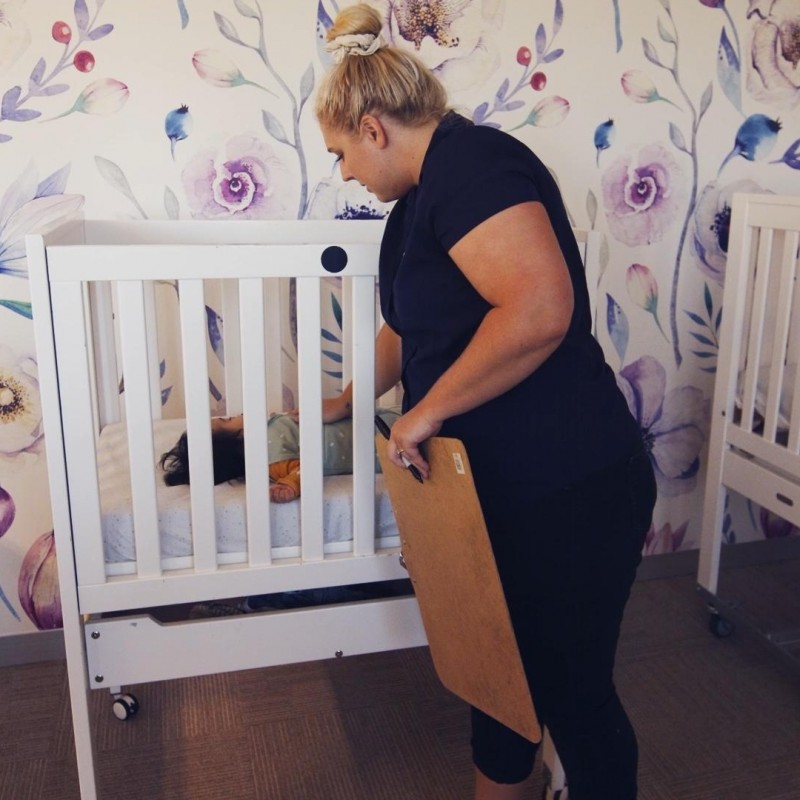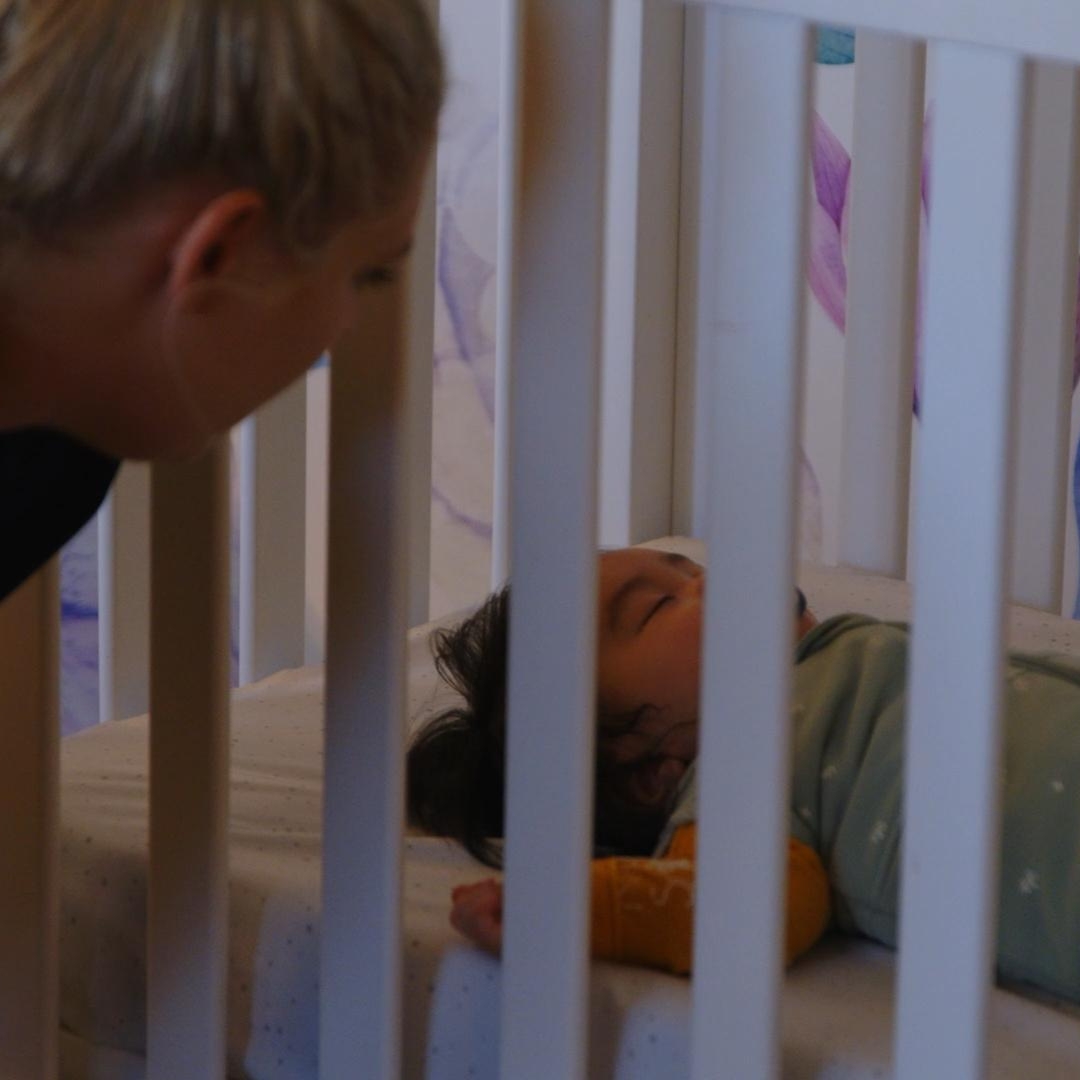Red Nose recognises continuous supervision, in which an educator is in sight and hearing of a sleeping child at all times, represents best practice.

The design of physical spaces for centre-based services, and the choice of infant sleeping spaces in family day care settings, should support continuous supervision wherever possible. Consideration should also be given to how educators position themselves within the space to promote continuous supervision.
Red Nose uses the Triple Risk Model to illustrate infant vulnerability and why SUDI (sudden unexpected death in infancy) may occur with particular babies. Infants and children with known risk factors for SUDI must be prioritised for continuous supervision. These risk factors include:
- infants under 7 months old,
- born prematurely or small for their gestational age,
- exposed to cigarette smoking or drugs or alcohol both in pregnancy and after birth
- with a medical condition or illness.
As documented by ACECQA in their Sleep and rest legislative requirements, there may be exceptional or extenuating circumstances or certain service settings where continuous supervision is not achievable at all times, for example, if an educator working alone is attending to another child’s needs. As part of the new sleep and rest risk assessment requirements, approved providers must assess and mitigate risks to address such circumstances to ensure children are adequately supervised. In all cases, safe sleep practices and regular physical checks must continue to be implemented.
Best practice guidance resources and templates can be downloaded from https://rednose.org.au/page/early-childhood-educators.
Why is this important?
SUDI is an umbrella term used to describe the sudden and unexpected death in infancy for which the cause is not immediately obvious. The only way to find out why an infant has died suddenly and unexpectedly is to perform an autopsy, review the clinical history and for a Coroner to investigate the circumstances of death.
Following investigation, some deaths are identified as accidental – for example, suffocation by bedclothes, pillows, or overlaying whilst co-sleeping. Infant deaths that are determined to be accidental and occur during sleep are labelled “fatal sleeping accidents”. When no cause can be found for the death of an infant, even after a full investigation, it is called SIDS (sudden infant death syndrome).
While the rate of infant deaths due to SUDI in Australia has declined dramatically since the early 1990s, over 100 infants die suddenly and unexpectedly each year. A small proportion of these deaths have occurred in Early Childhood Education and Care (ECEC) settings, including centre-based settings and family day care.
International research undertaken in the 1990s identified that of the SUDI deaths occurring in ECEC settings, the majority of deaths found that the infant was in the prone position (lying on their tummy). This highlights the importance of following safe sleep recommendations and the need for adequate supervision of infants during sleep and rest.
Why are infants vulnerable during sleep?
In order to fully understand an infant’s vulnerability in the sleep environment, it is important to understand how an infant’s anatomy differs to that of an older child or adult.
Infants are more vulnerable during sleep compared to older children and adults because they have:
- smaller, more easily compressed airways. An infant’s airway has a similar diameter to a drinking straw.
- large, heavy head relative to body size
- protruding back of the head, which causes their head to tip forward even when lying on their back on a flat surface
- more easily compressed chest wall
- less respiratory stamina
- reduced temperature control
- reduced sleep arousal to elevations in carbon dioxide
- if lying prone (on their tummy), a reduced ability to lift their face away from any obstruction, such as, a mattress.
These anatomical and physiological vulnerabilities are unique to an infant’s age and development stage. In addition, infants may have as many as seven upper respiratory tract infections in their first year of life, especially if they around older children. Even mild illnesses result in a degree of respiratory compromise.
Although infants under the age of 12 months are inherently more vulnerable to a sleep-related accident or injury occurring, ECEC services can reduce the risk of SUDI by following Red Nose’s six Safe Sleep recommendations and Best Practice Sleep and Rest Audit Tool for Education and Care Settings.
Continuous supervision is considered best practice because it provides a vigilant eye over infants at all times, minimising the risk of any potential harm and providing quick response should an incident occur.

Here’s why continuous supervision is essential:
1. Preventing sudden unexpected death in infancy (SUDI): Continuous supervision significantly reduces the risk of SUDI, including SIDS (sudden infant death syndrome) and other sleep-related incidents. By staying attentive, caregivers can swiftly respond to any signs of distress or discomfort, potentially averting a dangerous situation.
2. Monitoring the sleep environment: Continuous supervision allows educators to closely monitor the sleep environment for any signs of compromise. Factors such as overheating, poor ventilation, or the introduction of hazards into the sleep space can pose serious risks to infants. With vigilant supervision, these issues can be promptly identified and addressed, ensuring a safe sleeping environment for every child.
3. Identifying changes in wellbeing: Bedside checks play a critical role in monitoring the wellbeing of infants during sleep. By conducting regular checks, caregivers can observe subtle changes in an infant’s condition, such as changes in skin colour, laboured breathing or unusual movements. Detecting signs early allows for immediate intervention and ensures that any emerging health concerns are addressed promptly.
4. Maintaining safe sleep practices: Continuous supervision reinforces the importance of adhering to safe sleep practices consistently. Educators can ensure that infants are placed on their backs to sleep, in a firm and flat sleep surface, free from loose bedding or other suffocation hazards. By closely monitoring each sleeping infant, caregivers can uphold these guidelines and create a secure sleep environment for all.
In summary, continuous supervision is paramount in early childhood education and care settings to safeguard infants during sleep. By remaining vigilant and attentive supervision, educators can mitigate risks, monitor the sleep environment, identify changes in wellbeing, and uphold safe sleep practices effectively.
More resources for Early Childhood Educators
Last modified: 7/6/24
